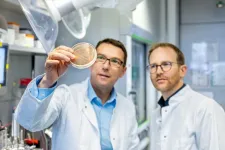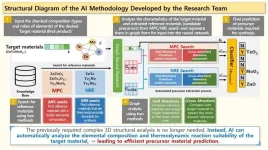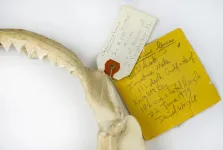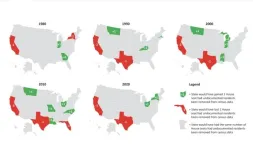(Press-News.org) There are reports of IT sabotage, cyber espionage, and other acts of hybrid warfare almost every day. Communication networks based on quantum physics could help eliminate threats of this kind. Researchers throughout Germany have already been working on developing those networks based on quantum repeaters for several years. In January 2025, the German Federal Ministry of Education and Research (BMBF) started funding a new research project, entitled Quantenrepeater.Net (QR.N), which aims to demonstrate the viability of quantum repeaters over test networks outside the protected lab environment. The BMBF will be providing a total of EUR 20 million over three years. The QR.N project coordinator is Professor Christoph Becher of Saarland University. Johannes Gutenberg University Mainz (JGU) contributes a subproject to the joint undertaking.
Quantum repeaters for fiber-based, long-range quantum communication
We all know repeaters as devices that tend to lurk in remote power sockets at home, boosting the signal provided by the Wi-Fi router to reach every corner of an apartment or a house. When positioned correctly, these little gadgets can significantly extend the range of data transmission. Researchers are also very interested in repeaters – not the ones you buy at the local electrical store, but much more complex quantum repeaters. In the new BMBF-funded QR.N project, 42 partners from research and industry are collaborating to make further progress in developing and implementing quantum communication networks.
Quantum networks for secure communication and the coupling of future quantum computers
In the future, quantum networks could be crucial for free and democratic societies and for the protection of critical infrastructure, as cyber sabotage, espionage, and hacking rapidly increase and threaten the sustainability of our interconnected world. Quantum networks would provide for a new level of security, because these networks would operate based on the laws of quantum physics, making them next to invulnerable to hacking or sabotage. The development of quantum repeaters able to ensure the secure transmission of information over longer distances would make quantum networks possible and represent significant progress towards the realization of a quantum-secured IT infrastructure. In addition, they would offer the prospect of the secure networking of future quantum computers.
However, researchers are faced with a major challenge. The quantum states necessary for quantum communication need to be generated in high quality, while transmission losses must be reduced to a minimum. In order to build a whole network from a simple connection between two points, nodes are required that are capable of temporarily caching the quantum states and transmitting them to the next node – as this is what repeaters do.
JGU subproject on the theoretical modeling and experimental realization of concepts
The new QR.N project is based on the Quantenrepeater.Link (QR.X) project, which was also funded by the BMBF – from 2021 to 2024 – and identified the basic requirements for the development of a quantum repeater. Part of both projects was and is a subproject at JGU, in which researchers consider quantum communication from experimental and theoretical perspectives.
The experimental research team, led by Professor Ferdinand Schmidt-Kaler of the JGU Institute of Physics, will be focusing on a specific platform – so-called defect centers in diamond – to be used as light storage interfaces. The diamond silicon-vacancy color centers that will be the subject of experimentation are characterized by narrow bandwidth light emission that is to be used for the spatial transmission of so-called quantum mechanical entangled states in the form of single-photon emission and detection. In addition to the color centers, the overall joint project will also concentrate on experimentally investigating atoms, ions, and semiconductor systems for their relevance to quantum repeater functioning. The theoretical project at JGU, headed by Professor Peter van Loock, will play a leading role in the theoretical modeling of all experimental quantum repeater platforms. "In addition to modeling quantum repeater systems as realistically as possible, we will explore new approaches that make greater use of the concept of quantum error correction, a technique known in quantum computing, and adapt it to the needs of a quantum repeater. The resultant quantum repeater should make it easier in the experimental context to deal with the very complex issues relating to robustness and life span of quantum storage systems. Perhaps it will even prove possible to create optical quantum repeaters that can operate without transient storage," explained van Loock.
The project consortium aims to develop the basic framework for "quantum-secure" communication to be established in Germany in the next few years. This is of major societal relevance, especially with regard to the security of IT systems and the protection of critical infrastructures. However, quantum repeaters are not intended to become a mass-produced electronic product for everyday private use.
General background
Quantenrepeater.Net (QR.N) was launched on 1 January 2025. The German Federal Ministry of Education and Research will fund the project with EUR 20 million to be provided over three years. A total of 42 research institutions and enterprises are cooperating in QR.N with the aim of developing the basic requirements for a quantum-communication network structure based on quantum repeaters. The QR.N project will take up the results of the Quantenrepeater.Link (QR.X) project, funded by the BMBF from 2021 to 2024. Coordinated by Professor Christoph Becher of Saarland University, this project identified the basic requirements for the development of a quantum repeater, itself building on various related projects undertaken since 2010.
Related links:
https://www.oqit.uni-mainz.de/ – Optical Quantum Information Theory group of Professor Peter van Loock at the JGU Institute of Physics
https://www.quantenbit.physik.uni-mainz.de/quantum-network-and-repeaters/ – Quantum network and repeaters project in the Quantenbit group of Professor Ferdinand Schmidt-Kaler at the JGU Institute of Physics
https://www.uni-saarland.de/en/chair/becher.html – Quantum Optics group of Professor Christoph Becher at the Physics Department at Saarland University
:
https://press.uni-mainz.de/a-physical-qubit-with-built-in-error-correction/ – press release "A physical qubit with built-in error correction" (2 Feb. 2024)
https://press.uni-mainz.de/eur-16-million-for-photonic-quantum-processors/ – press release "EUR 16 million for photonic quantum processors" (1 Feb. 2022)
https://press.uni-mainz.de/quantum-communication-research-network-launched/ – press release "Quantum communication research network launched" (10 Dec. 2021)
https://press.uni-mainz.de/miliquant-putting-quantum-technology-into-practice/ – press release "MiLiQuant: Putting quantum technology into practice" (1 July 2019)
https://press.uni-mainz.de/full-steam-ahead-to-the-quantum-web-mainz-university-is-involved-in-european-flagship-on-quantum-technologies-program/ – press release "Full steam ahead to the quantum web: Mainz University is involved in European Flagship on Quantum Technologies program" (30 Oct. 2018 END
New joint project to investigate quantum repeaters designed to provide for secure quantum communication networks of the future
German Federal Ministry of Education and Research will fund the new partnership project with EUR 20 million for three years / Subproject at Mainz University involves both theoretical modeling and experimental realization
2025-02-11
ELSE PRESS RELEASES FROM THIS DATE:
PhRMA Foundation welcomes two board members
2025-02-11
The PhRMA Foundation announced the appointment to its Board of Directors of Dr. John C. Reed, MD, PhD, Executive Vice President of Innovative Medicine R&D at Johnson & Johnson (J&J), and Dr. Donatello Crocetta, MD, MBA, Chief Medical Officer and Head of Medical Communities at UCB.
The PhRMA Foundation is a 60-year-old nonprofit that fosters biopharmaceutical innovation and value-driven health care by investing in the frontiers of research. The Foundation catalyzes the careers of promising researchers through competitive, ...
Microbiome as a potential key to better treatment: Clinical study on new therapy for Crohn's disease
2025-02-11
A special liquid diet, known as exclusive enteral nutrition, is an essential therapy for Crohn's disease. Patients consume only this formula for six to eight weeks, completely avoiding solid foods. However, the exact reasons why this is helpful were previously unclear. Researchers at the Technical University of Munich (TUM) and the LMU University Hospital Munich have now been able to decipher the mechanism behind this dietary therapy. Based on these results, they are launching a clinical study combining dietary therapy with faecal microbiome transfer to further enhance ...
AI predicts the precursor materials needed for material synthesis
2025-02-11
Researchers in Korea have developed a technology that automatically identifies the necessary precursor materials to synthesize specific target materials.
A joint research team led by Senior Researcher Gyoung S. Na from the Korea Research Institute of Chemical Technology (KRICT) and Professor Chanyoung Park from the Korea Advanced Institute of Science and Technology (KAIST) has developed an AI-based retrosynthesis methodology that predicts the required precursor materials solely based on the chemical formula of the target material without expensive material descriptors ...
International Shark Attack File Report: Unprovoked shark bites plummeted in 2024
2025-02-11
2024 was an exceptionally calm year for shark bites. Worldwide, there were only 47 unprovoked attacks, down 22 from the previous year and well below the 10-year average of 70. Four of last year’s attacks resulted in fatalities, also a significant reduction from recent years.
The International Shark Attack File, maintained by the Florida Museum of Natural History, provides data on what are considered unprovoked bites, defined as incidents in which a person does not initiate contact with a shark. Instances in which a person intentionally or unintentionally initiates contact, including spearfishing and releasing sharks ...
Ketamine for mental health should only be provided by trained professionals
2025-02-11
CHICAGO – The anesthetic ketamine is being hailed as a breakthrough therapy for people with post-traumatic stress disorder (PTSD), treatment-resistant depression and other mood disorders. But the drug does have side effects – some potentially life-threatening – and should only be prescribed and administered by trained health care professionals to ensure the patient’s safety, according to new guidance released by the American Society of Anesthesiologists (ASA).
Long valued for its role in sedation and anesthesia during medical procedures, ...
Study takes a ‘bite’ out of shark depredation using citizen science
2025-02-11
Shark depredation is a hot-button issue in recreational fishing, as anglers face off against these stealthy ocean bandits. These underwater thieves snatch fish straight off the line, often leaving nothing but scraps – or a broken leader – as evidence of their heist.
The Southeast, a major hub for saltwater fishing, is a depredation “hot spot” due to high fishing activity. While fisheries managers in the United States monitor shark depredation in commercial fisheries, efforts to evaluate these interactions in recreational fishing have been limited.
With Florida’s recreational ...
A gender gap in using AI for research
2025-02-11
After the launch of ChatGPT male researchers’ productivity rate increased, pointing to a gender difference in how scientists use AI. Previous work has shown that men are more likely to use generative AI in their work than women. Shaobo Li and colleagues analyzed preprints uploaded to the Social Science Research Network (SSRN), one of the largest open-access repositories in the world, from May 2022 to June 2023. ChatGPT was released in late November 2022. After the release of ChatGPT, the productivity of male researchers significantly increased relative to that of female researchers, with the probability ...
Human-caused fires growing faster than lightning fires in the Western US
2025-02-11
A study shows that there are almost twice as many risky days for large human-caused fires in the American West as there are for lightning-caused fires, due to differences in the level of heat and aridity under which each type of fire is likely to occur. The discrepancy is not accounted for in most fire early warning systems. In addition, risky days for human-caused fires are growing faster than risky days for lighting-caused fires as the climate warms.
Fa Li and colleagues focused on Vapor Pressure Deficit (VPD), which captures both dryness ...
Barbeque and grandma’s cookies: New study looks at nostalgia, comfort in food preparation for older adults
2025-02-11
PULLMAN, Wash. — Foods that evoke a sense of nostalgia and comfort and have good texture variety are important considerations in prepared meals aimed at older adults, according to new Washington State University research.
“We want to help the prepared food industry produce appetizing, healthy meals for older adults,” said Carolyn Ross, professor in WSU’s School of Food Science. “Malnutrition is quite prevalent in people over 60 because food may be available, but they won’t eat it if they don’t like it. We want to walk a line where food is tasty, convenient, and full of nutrients.”
In a paper recently published ...
The political consequences of undocumented residents in the census
2025-02-11
In recent years, some public figures have argued that undocumented residents in the United States should not be included in census data used for congressional apportionment because their inclusion unfairly benefits Democratic-leaning states. John Robert Warren and Robert E. Warren analyzed data from every census from 1980 through 2020 and used high quality state-level estimates of the size of the undocumented resident population at each time point. The authors then calculated how many House seats and how many Electoral College votes would have changed had undocumented residents been excluded from the data after each census. Previous efforts to ...
LAST 30 PRESS RELEASES:
Heart-brain connection: international study reveals the role of the vagus nerve in keeping the heart young
Researchers identify Rb1 as a predictive biomarker for a new therapeutic strategy in some breast cancers
Survey reveals ethical gaps slowing AI adoption in pediatric surgery
Stimulant ADHD medications work differently than thought
AI overestimates how smart people are, according to HSE economists
HSE researchers create genome-wide map of quadruplexes
Scientists boost cell "powerhouses" to burn more calories
Automatic label checking: The missing step in making reliable medical AI
Low daily alcohol intake linked to 50% heightened mouth cancer risk in India
American Meteorological Society announces Rick Spinrad as 2026 President-Elect
Biomass-based carbon capture spotlighted in newly released global climate webinar recording
Illuminating invisible nano pollutants: advanced bioimaging tracks the full journey of emerging nanoscale contaminants in living systems
How does age affect recovery from spinal cord injury?
Novel AI tool offers prognosis for patients with head and neck cancer
Fathers’ microplastic exposure tied to their children’s metabolic problems
Research validates laboratory model for studying high-grade serous ovarian cancer
SIR 2026 delivers transformative breakthroughs in minimally invasive medicine to improve patient care
Stem Cell Reports most downloaded papers of 2025 highlight the breadth and impact of stem cell research
Oxford-led study estimates NHS spends around 3% of its primary and secondary care budget on the health impacts of heat and cold in England
A researcher’s long quest leads to a smart composite breakthrough
Urban wild bees act as “microbial sensors” of city health.
New study finds where you live affects recovery after a hip fracture
Forecasting the impact of fully automated vehicle adoption on US road traffic injuries
Alcohol-related hospitalizations from 2016 to 2022
Semaglutide and hospitalizations in patients with obesity and established cardiovascular disease
Researchers ‘listen in’ to embryo-mother interactions during implantation using a culture system replicating the womb lining
How changing your diet could help save the world
How to make AI truly scalable and reliable for real-time traffic assignment?
Beyond fragmented markets: A new framework for efficient and stable ride-pooling
Can shape priors make road perception more reliable for autonomous driving?
[Press-News.org] New joint project to investigate quantum repeaters designed to provide for secure quantum communication networks of the futureGerman Federal Ministry of Education and Research will fund the new partnership project with EUR 20 million for three years / Subproject at Mainz University involves both theoretical modeling and experimental realization





